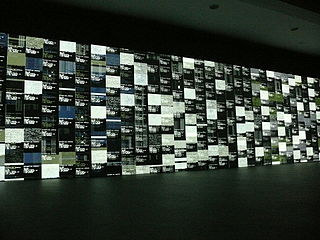 W
WPostmodern art is a body of art movements that sought to contradict some aspects of modernism or some aspects that emerged or developed in its aftermath. In general, movements such as intermedia, installation art, conceptual art and multimedia, particularly involving video are described as postmodern.
 W
WIdea art is an art form in which small individual idea(s) and not the grand concept(s) or ideologies involved in the work take precedence over generic aesthetic, material and disciplinary concerns. Works of idea art may be in text, found object, 2d, 3d, moving images, sound, performance, digital, interactive media and/or as installations. This method was fundamental to Turkish artist Genco Gulan's definition of idea art, one of the first to appear online.
 W
WSite-specific art is artwork created to exist in a certain place. Typically, the artist takes the location into account while planning and creating the artwork. Site-specific art is produced both by commercial artists, and independently, and can include some instances of work such as sculpture, stencil graffiti, rock balancing, and other art forms. Installations can be in urban areas, remote natural settings, or underwater.
 W
WAgrippa is a work of art created by science fiction novelist William Gibson, artist Dennis Ashbaugh and publisher Kevin Begos Jr. in 1992. The work consists of a 300-line semi-autobiographical electronic poem by Gibson, embedded in an artist's book by Ashbaugh. Gibson's text focused on the ethereal, human-owed nature of memories retained over the passage of time. Its principal notoriety arose from the fact that the poem, stored on a 3.5" floppy disk, was programmed to encrypt itself after a single use; similarly, the pages of the artist's book were treated with photosensitive chemicals, effecting the gradual fading of the words and images from the book's first exposure to light.
 W
WBlood Cross is one of American photographer Andres Serrano's early religious-themed postmodernist images, released in 1985, two years before the controversial Piss Christ was debuted. This image depicted a plexiglass cross filled with cow's blood; the cross leaked slightly making it appear as though it was bleeding. It was exhibited along with Milk, Blood as part of Serrano's Fluids series.
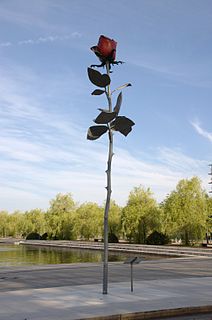 W
WContemporary art is the art of today, produced in the second half of the 20th century or in the 21st century. Contemporary artists work in a globally influenced, culturally diverse, and technologically advancing world. Their art is a dynamic combination of materials, methods, concepts, and subjects that continue the challenging of boundaries that was already well underway in the 20th century. Diverse and eclectic, contemporary art as a whole is distinguished by the very lack of a uniform, organising principle, ideology, or "-ism". Contemporary art is part of a cultural dialogue that concerns larger contextual frameworks such as personal and cultural identity, family, community, and nationality.
 W
WDie Plage is a large-scale photomontage installation by artist and composer Harley Gaber (1943–2011) consisting of roughly 4,200 canvases that interpret German history from the Weimar Republic to the end of World War II. Gaber worked on Die Plage between 1993 and 2002, incorporating paint, charcoal, and xerography into his photomontage technique, and exhibiting the work in several stages of completion. As of September 2020, Die Plage has not yet been exhibited in its entirety, which would run over 1,680 feet (510 m) long were it displayed as intended in a series of panels, five canvases high, about 12 feet (3.7 m).
 W
WElectronic art is a form of art that makes use of electronic media. More broadly, it refers to technology and/or electronic media. It is related to information art, new media art, video art, digital art, interactive art, internet art, and electronic music. It is considered an outgrowth of conceptual art and systems art.
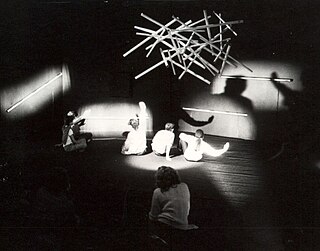 W
WInteractive art is a form of art that involves the spectator in a way that allows the art to achieve its purpose. Some interactive art installations achieve this by letting the observer or visitor "walk" in, on, and around them; some others ask the artist or the spectators to become part of the artwork.
 W
WMail art, also known as postal art and correspondence art, is an artistic movement centered on sending small-scale works through the postal service. It initially developed out of what eventually became Ray Johnson's New York Correspondence School and the Fluxus movements of the 1960s, though it has since developed into a global movement that continues to the present.
 W
WMusic for Electric Metronomes is an avant-garde aleatoric composition written in 1960 by Japanese composer Toshi Ichiyanagi for any number of performers between three and eight. The piece involves the manipulation of electric metronomes, followed by various unspecified sounds and actions. It is a very theatrical piece, and reflects Ichiyanagi's affiliation with Fluxus, an experimental art movement from the sixties. The only true scored "instrument" is an electric metronome for each individual player, though the varying sounds and/or actions may involve many different instruments and objects at the discretion of the performer. Because the graphic notation of the score—a series of dashes, lines, and numbers in an erratic pattern of connected paths—leaves room for personal interpretation and expression, each performance is unique, and almost certainly cannot be reproduced. There is no conductor for the performance. It has been recorded on the album Toshi Ichiyanagi: 1960's & 1990's. In a review of a performance by the S.E.M. Ensemble in 1992 at the Paula Cooper Gallery, the music critic of The New York Times, Alex Ross, described the piece as "merely a timid, spastic prelude to György Ligeti's monumental Poème symphonique" for 100 metronomes".
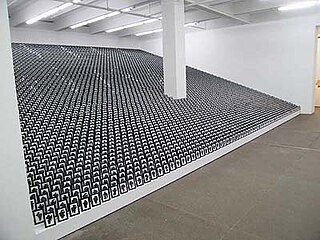 W
WNeo-conceptual art describes art practices in the 1980s and particularly 1990s to date that derive from the conceptual art movement of the 1960s and 1970s. These subsequent initiatives have included the Moscow Conceptualists, United States neo-conceptualists such as Sherrie Levine and the Young British Artists, notably Damien Hirst and Tracey Emin in the United Kingdom, where there is also a Stuckism counter-movement and criticism from the 1970s conceptual art group Art and Language.
 W
WNeo-expressionism is a style of late modernist or early-postmodern painting and sculpture that emerged in the late 1970s. Neo-expressionists were sometimes called Transavantgarde, Junge Wilde or Neue Wilden. It is characterized by intense subjectivity and rough handling of materials.
 W
WImmersion is a 1987 photograph by the American artist and photographer Andres Serrano. It depicts a small plastic crucifix submerged in a small glass tank of the artist's urine. The piece was a winner of the Southeastern Center for Contemporary Art's "Awards in the Visual Arts" competition, which was sponsored in part by the National Endowment for the Arts, a United States Government agency that offers support and funding for artistic projects.
 W
WPolish postmodernism refers to the cultural, artistic and philosophical development within the Polish society coinciding with the downfall of communism and the democratic transitions leading to Poland's 2004 accession into the European Union.
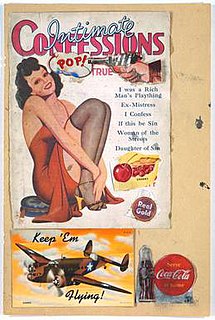 W
WPop art is an art movement that emerged in the United Kingdom and the United States during the mid- to late-1950s. The movement presented a challenge to traditions of fine art by including imagery from popular and mass culture, such as advertising, comic books and mundane mass-produced objects. One of its aims is to use images of popular culture in art, emphasizing the banal or kitschy elements of any culture, most often through the use of irony. It is also associated with the artists' use of mechanical means of reproduction or rendering techniques. In pop art, material is sometimes visually removed from its known context, isolated, or combined with unrelated material.
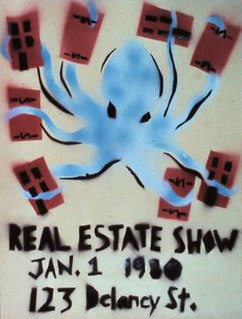 W
WThe Real Estate Show was a squatted exhibition by New York artists' group Colab, on the subject of landlord speculation in real estate held on New Year's Day in a vacant city-owned building at 123 Delancey Street in the Lower East Side of Manhattan, New York City.
 W
WThe Rover chair is the first piece of furniture designed by industrial designer Ron Arad. It was made in 1981 as a fusion of two readymades and launched Arad's career. The chair is a postmodernist design, combining a car seat with a structural tubing frame.
 W
WSystems art is art influenced by cybernetics, and systems theory, that reflects on natural systems, social systems and social signs of the art world itself.
 W
WThe Thing is an international net-community of artists and art-related projects that was started in 1991 by Wolfgang Staehle. The Thing was launched as a mailbox system accessible over the telephone network in New York feeding a Bulletin Board System (BBS) in 1991 before their website was launched in 1995 on the World Wide Web. By the late 1990s, The Thing grew into a diverse online community made up of dozens of members' Web sites, mailing lists, a successful Web hosting service, a community studio in Chelsea (NYC), and the first Web site devoted to Net Art: bbs.thing.net.
 W
WThe Times Square Show was an influential collaborative, self-curated, and self-generated art exhibition held by New York artists' group Colab in Times Square in a shuttered massage parlor at 201 W. 41st and 7th Avenue during the entire month of June in 1980. The Times Square Show was largely inspired by the more radical Colab show The Real Estate Show, but unlike it, was open 24hours a day, 7 days a week, in what was then a Times Square full of porno theaters, peep shows, and red light establishments. In addition to experimental painting and sculpture, the exhibition incorporated music, fashion, and an ambitious program of performance and video. For many artists the exhibition served as a forum for the exchange of ideas, a testing-ground for social-directed figurative work in progress, and a catalyst for exploring new political-artistic directions.